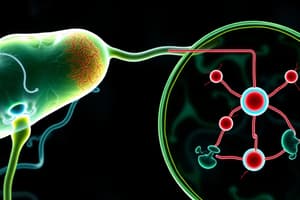Podcast
Questions and Answers
What is the main role of plastocyanin in the electron transport chain?
What is the main role of plastocyanin in the electron transport chain?
- To synthesize ATP through ADP phosphorylation
- To absorb solar energy for re-excitation of electrons
- To transfer low-energy electrons to PSI (correct)
- To transfer high-energy electrons to the reaction center
Which process begins the Calvin cycle?
Which process begins the Calvin cycle?
- The reduction of G3P
- The absorption of solar energy by PSII
- The reaction of CO2 with RuBP (correct)
- The conversion of NADP to NADPH
In the process of electron transport, what effect does the downhill movement of H+ ions have?
In the process of electron transport, what effect does the downhill movement of H+ ions have?
- It pumps electrons across the thylakoid membrane
- It synthesizes NADPH directly from NADP
- It reduces 3-PGA to G3P
- It drives ATP synthesis via ATP synthase (correct)
How are G3P molecules utilized in the Calvin cycle?
How are G3P molecules utilized in the Calvin cycle?
Which statement accurately describes a similarity between cellular respiration and photosynthesis?
Which statement accurately describes a similarity between cellular respiration and photosynthesis?
Which enzyme is responsible for the conversion of glucose to glucose-6-phosphate in glycolysis?
Which enzyme is responsible for the conversion of glucose to glucose-6-phosphate in glycolysis?
What are the net products of glycolysis?
What are the net products of glycolysis?
What is the initial step that pyruvate must undergo before entering the Krebs cycle?
What is the initial step that pyruvate must undergo before entering the Krebs cycle?
During the Krebs cycle, which of the following molecules is formed when acetyl-CoA combines with oxaloacetate?
During the Krebs cycle, which of the following molecules is formed when acetyl-CoA combines with oxaloacetate?
What is produced during the transition reaction of pyruvate to acetyl-CoA?
What is produced during the transition reaction of pyruvate to acetyl-CoA?
Which process involves the passive return of H+ ions into the mitochondrial matrix?
Which process involves the passive return of H+ ions into the mitochondrial matrix?
Which of the following occurs in the electron transport chain?
Which of the following occurs in the electron transport chain?
What stage of photosynthesis is similar to the oxidative processes described in cellular respiration?
What stage of photosynthesis is similar to the oxidative processes described in cellular respiration?
Flashcards
Photosynthesis Electron Transport
Photosynthesis Electron Transport
Electrons move through complexes, pumping H+ and generating ATP and NADPH.
Calvin Cycle Input
Calvin Cycle Input
CO2 reacts with RuBP to form 3-PGA, using ATP and NADPH.
Photosynthesis's Energy Source
Photosynthesis's Energy Source
Light energy from the sun is absorbed by chlorophyll, providing the energy required.
ATP and NADPH Role in Calvin Cycle
ATP and NADPH Role in Calvin Cycle
Signup and view all the flashcards
Photosynthesis Reduction/Oxidation
Photosynthesis Reduction/Oxidation
Signup and view all the flashcards
NAD+ to NADH
NAD+ to NADH
Signup and view all the flashcards
Glycolysis enzymes
Glycolysis enzymes
Signup and view all the flashcards
Glycolysis net products
Glycolysis net products
Signup and view all the flashcards
Pyruvate to Acetyl-CoA
Pyruvate to Acetyl-CoA
Signup and view all the flashcards
Krebs cycle inputs
Krebs cycle inputs
Signup and view all the flashcards
Krebs cycle outputs
Krebs cycle outputs
Signup and view all the flashcards
Electron transport chain
Electron transport chain
Signup and view all the flashcards
Chemiosmosis
Chemiosmosis
Signup and view all the flashcards
Study Notes
Glycolysis
- Glycolysis breaks down glucose into pyruvate
- Enzymes used in glycolysis: Hexokinase, phosphoglucoisomerase, phosphofructokinase, aldolase, triosephosphate isomerase, glyceraldehyde-3-phosphate dehydrogenase, phosphoglycerate kinase, phosphoglycerate mutase, enolase, pyruvate kinase
- Mnemonic for enzyme order: "H E P UT THE P HONE A ND TRI ED TO G ET THE P LASTIC P LATE TO E AT P IE"
- Net products of glycolysis: 2 ATP, 2 NADH, 2 pyruvate
Transition Reaction
- Pyruvate, a three-carbon molecule, must be oxidized to acetyl-CoA
- Occurs in the mitochondrion under aerobic conditions.
- Converts pyruvate into acetyl-CoA
- Produces CO2 and NADH
Krebs Cycle
- Oxidizes pyruvate molecules to produce energy
- Acetyl-CoA combines with oxaloacetate to form citrate
- Subsequent oxidation produces CO2, NADH, and FADH2
- Electron carriers (NADH and FADH2) enter the electron transport chain
Electron Transport Chain
- Oxidizes NADH and FADH2
- Releases electrons that pump hydrogen ions (H+) from the matrix to the intermembrane space
Chemiosmosis
- H+ passively returns to the matrix via ATP synthase
- This movement powers ATP synthase to produce ATP from ADP and inorganic phosphate
Photosynthesis: Light-Dependent Reactions
- Absorbs radiant energy from the sun via chlorophyll
- Excitation of electrons in photosystem II (PSII) moves them to the reaction center and electron transport complexes
- Electron transport pumps H+ from the stroma to the thylakoid lumen
- H+ movement drives ATP synthesis via ATP synthase
- Plastocyanin transfers low-energy electrons to photosystem I (PSI)
- PSI re-excites electrons via solar energy absorption
- Electrons move to ferredoxin and NADP reductase, reducing NADP+ to NADPH
Photosynthesis: Calvin Cycle
- Utilizes ATP and NADPH from the light-dependent reactions
- Carbon dioxide (CO2) reacts with RuBP (ribulose-1,5-bisphosphate) using RuBisCO
- Produces 3-PGA, which is reduced by ATP and NADPH to form G3P
- G3P used to produce glucose and regenerate RuBP
Cellular Respiration vs Photosynthesis (Similarities)
- Both involve redox reactions and ATP synthesis from electron flow through protein complexes and ADP phosphorylation
Studying That Suits You
Use AI to generate personalized quizzes and flashcards to suit your learning preferences.




